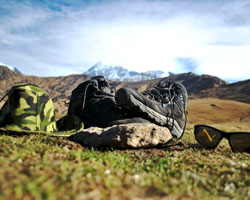Himalayas are Sacred; So are Most of the Treks
The Himalayas are the soul of India or the entire Indian subcontinent. These are the youngest mountain ranges in the world, the abode of gods and the birthplace of sacred rivers that nourish and empower millions of lives on their journey to the oceans. Hinduism, Buddhism, Sikhism, and many other spiritual traditions have deep roots in these mountains, where the divine often meets the human.
Whether in ancient scriptures, the silence of meditating saints, or the footsteps of everyday seekers, the Himalayas have long been a sanctuary for those seeking peace, enlightenment, a sense of presence, or simply the raw beauty of nature. Towering peaks, sacred lakes, hidden caves, and age-old temples scattered through these ranges have made them a timeless symbol of spiritual pursuit.
But the sacredness of these mountains isn’t only about religion. It lies in the very act of getting there, where your body becomes the instrument of devotion.
To walk through dense forests, climb snow-covered slopes, and trace ancient riverbeds is to experience, in motion, the deep connection between body, mind, and spirit.
Trekking in the Indian Himalayas goes beyond endurance. It’s a spiritual journey that tests your limits and heals something deeper. Each trek becomes more than just a trail. It becomes a path to self-discovery and inner stillness.

The Spiritual Act of Trekking
Trekking should never be about the summit. It’s always about the journey, and the summit is just a part of it. The decisions you make, the mindfulness required to walk across varied terrains, the humility to surrender to nature, and the act of disconnecting from the chaos of the world—all of it transforms the trail into a form of tapasya (spiritual discipline). Hardship leads to wisdom. The struggle brings clarity. Realizations that would never have emerged in comfort surface on the mountain.
The constant noise of life, work, relationships, and social media is left behind. In its place: silence and stillness. You begin to hear your thoughts loud and clear. Your inner voice grows stronger. Your physical endurance is pushed past limits. Your mental strength steps up.
Trekking is as much a physical act as it is an act of surrender. When you leave behind comfort, when you walk up steep slopes, battle cold winds, and trudge through snow, you begin to understand that trekking in the Himalayas is about letting go of control, of fear, of baggage, and expectations.
And in return, the mountains offer something deeper. Every rugged stretch, every uphill struggle, becomes not just a test of strength but an invitation to reflect, to connect, and to find a rare kind of peace. The kind that comes only from walking through the wild.

Sacred Treks You can do in the Indian Himalayas
Although every trek has the potential to move your soul, there are a few that people undertake specifically for their sacred significance. The concept of Tirth in Hinduism encourages spiritual journeys to places like the Char Dham, Panch Kedar, Panch Kailash, and many revered lakes and mountains.
Most pilgrims visit these places out of devotion, often focusing on a particular temple or sacred spot. But when you trek to these regions, the experience goes beyond the destination. The sacredness becomes part of the journey itself.
Here, we’ve listed a few spiritual treks you can and should experience, along with the stories and significance that make them more than just trails.
-
Gaumukh Tapovan Trek

Gaumukh Tapovan isn’t just the source of the Ganga—it’s a walk into the mythology of an entire civilization. Beginning at Gangotri and climbing past the snout of the mighty Gangotri Glacier to the high-altitude meadows of Tapovan, this trek takes you to the birthplace of India’s most sacred river. The terrain is raw, challenging, and humbling, but the reward is deeper than the view—it's a spiritual reset. Every step here feels like a return, not just to nature, but to something ancient within yourself.
Pilgrims walk from Gangotri to Gaumukh to take a holy dip in the icy waters of the Ganga at its source. Along the way, you’ll often spot sadhus deep in their sadhna, quietly absorbed in the spiritual energy of the region. Most pilgrims stop at Gaumukh, but the trail doesn’t end there. A steep climb leads further up to Tapovan—a sacred alpine meadow at the base of Mt. Shivling. Just beyond, the mighty Bhagirathi massif stands in full, awe-inspiring view.
-
Bali Pass

Starting from Sankri and ending at Janki Chatti via Yamunotri, Bali Pass is a rare Himalayan trail that blends spiritual legacy with raw, untamed beauty. It’s not just a route. It’s a passage through myth and mountain.
As you trek through high ridgelines and glacial terrain, you also pass through Yamunotri, the sacred origin of the Yamuna River and one of the Char Dhams of Uttarakhand. Few treks allow you to witness the collision of such physical challenge and spiritual presence in one journey.
Bali Pass is not for beginners. It’s a demanding trail meant for those who’ve already earned their legs in the mountains. But for the seasoned trekker who seeks more than just altitude, for someone searching for perspective, humility, and stillness, this route delivers.
-
Satopanth Lake

Satopanth means "Path of Truth." This isn’t a trek, this is a journey on the path of truth.
Starting from Mana, the last village before the Indo-Tibetan border, this high-altitude glacial lake in Uttarakhand sits cloaked in lore and silence. Believed to be the meditative ground of the Hindu trinity Brahma, Vishnu, and Mahesh, each corner of the triangular lake is said to hold the energy of creation, preservation, and destruction. This is also the path the Pandavas are said to have taken to reach heaven, with Satopanth marking a crucial stop on the celestial staircase of Swargarohini. Mythical birds are believed to guard the lake and keep it clean. Some say they’re Gandharvas. Others don’t try to explain it. Maybe because up here, you don’t need answers—you just need presence.
On this trek, you follow the roaring Alaknanda River, cross alpine meadows like Lakshmi Van and Chakrateerth, all under the gaze of the mighty Chaukhamba massif. If the skies are kind, you’ll even catch a glimpse of the legendary Swargarohini steps—the final steps to the divine.
-
Tungnath - Chandrashila

Most treks take you to summits; this one takes you to gods.
The Tungnath–Chandrashila trek is where myth, devotion, and panoramic Himalayan glory collide. Home to Tungnath, the highest Shiva temple in the world, and the summit of Chandrashila, where Lord Rama is said to have meditated after defeating Ravana, this trail is soaked in spiritual gravity.
Part of the sacred Panch Kedar circuit, Tungnath is believed to be where the arms of Lord Shiva surfaced after he took the form of a bull to avoid the Pandavas. It’s not just a place of worship—it’s a chapter from the Mahabharata carved into the mountains.
But here’s the twist—come in winter, and you’ll see a different story unfold.
The temple doors are shut. The snow is deep. The stone steps are buried. There are no priests, no flower stalls, no ringing bells—just white silence, and you. What was once a busy pilgrimage turns into a quiet, raw challenge. A spiritual trail frozen into solitude.
Chandrashila, the summit above Tungnath, becomes the real test. A steep snow-climb that rewards you with one of the most stunning 360-degree views in the Indian Himalayas—including Nanda Devi, Trishul, and Chaukhamba, standing like ancient sentinels of this sacred place.
In summer, this is a family trek. In winter, it’s something else entirely. Fewer people. More snow. More soul.
-
Bhrigulake

Perched above Manali at 14,100 ft, Bhrigu Lake is named after Maharishi Bhrigu, the sage said to have meditated at its shores. This lake carries centuries of silence. In local belief, it’s not just water held by mountains, it’s water that has held gods. The lake, wrapped in mist and reverence, is believed to be a site where deities and sages bathed and meditated. Even in winter lake never freezes completely. Not because of the sun. But because of the energy left behind by the sage himself.
Bhrigu is not a hard trek by Himalayan standards. But it will stay with you.
-
Dodital

Dodital, also known as Dhundital, sits calmly in the Uttarakhand Himalayas, believed to be the birthplace of Lord Ganesha.
Tucked amidst dense oak and deodar forests, this freshwater lake holds more than just glacial melt. It holds a story. A legend. A quiet sacredness that isn’t loud or dramatic—it’s just there, steady as the waters that have stayed holy for centuries.
On the banks of the lake stands a temple dedicated to Ganesha, drawing pilgrims who believe that the god of beginnings was born right here. Locals call it Dhundital—“Ganesha’s lake”—and the entire trail leading to it feels like walking through the pages of an old, familiar scripture.
But don’t expect crowds or big rituals. This is not a mainstream pilgrimage—it’s a personal one. The kind where silence teaches you more than sermons. The kind where the forest feels like it’s watching you walk, and the lake, when you finally arrive, feels less like a destination and more like a presence.
As treks go, Dodital is gentle. But as journeys go, it’s anything but ordinary.
Vyas Kund, Kedar Tal, and the Hampta Pass Trek are among the other Himalayan trails where the line between adventure and spiritual resonance blurs. Vyas Kund is believed to be the meditation site of Sage Ved Vyas himself, while Kedar Tal sits like a silver offering at the foot of mighty Mt. Thalaysagar, sacred to Lord Shiva. Even Hampta Pass, though better known for its dramatic crossover between valleys, carries a quiet reverence—walking through it feels less like covering distance and more like moving through stories older than time.
Trek for the Soul
When you embark on a spiritual trek in the Indian Himalayas, you’re not just hiking through challenging terrain. You’re walking a path of transformation. Each trek, each mountain pass, each prayer flag fluttering in the wind is a reminder that the Himalayas are more than just peaks; they are a spiritual sanctuary where the body, mind, and soul find alignment.
Trekking in the Himalayas is not just about the physical summit; it’s about the summit of your soul. Long after the mountain fades into memory, the lessons learned, the clarity gained, and the spiritual connection you feel will stay with you forever.






